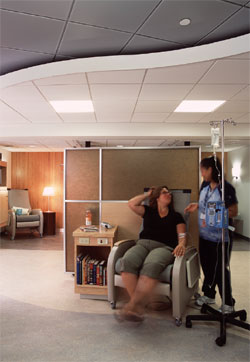Case studies show how leading businesses are eliminating toxic chemicals from their supply chains, asking chemical manufacturers for more safety information, and calling on Congress to put common-sense limits on chemicals that could harm their customers.

By Robin Guenther, FAIA, Principal
 At Perkins+Will we design structures that achieve our clients’ vision while maintaining the company’s founding principles of sustainability, integrity and design excellence.
At Perkins+Will we design structures that achieve our clients’ vision while maintaining the company’s founding principles of sustainability, integrity and design excellence.
Materials Selection Matters
We recognize that materials selected for use in our projects will impact those who build, occupy and maintain our buildings both today and for generations to come. Poor indoor air quality has been identified by the US Environmental Protection Agency (EPA) as among the top five environmental risks to public health, yet Americans spend an average of 90% of their time indoors. For infants, the elderly and urban residents, the percentage of time indoors may be even higher. In a quest for improved energy efficiency, the building industry continues to design tighter building envelopes that require more focus on material emissions and constituent components.
Robin Guenther, Principal, Perkins+Will
Beyond immediate exposure, some building materials may present a health risk at other points in their life cycle. Polyvinyl chloride (PVC) plastic, for example, is ubiquitous in pipes, conduit, siding, doors, windows and other uses. Dioxin— a persistent, bioaccumulative and toxic (PBT) chemical—may be formed during PVC manufacture, garbage incineration and accidental building fires. DEHP, a phthalate used to soften PVC plastic, is a reproductive toxicant and can leach from PVC products. In addition, many building materials contain heavy metals such as lead and cadmium. Still others, such as epoxy coatings, contain bisphenol-A, an endocrine disruptor. Finally, because of current industry practices, design professionals, building owners and constructors rarely know the full range of potentially hazardous chemicals that may be contained at low levels in specified or supplied materials — either because the contents are not disclosed, are not measured and/or the chemicals have not been tested.
In keeping with our 2007–2010 Sustainable Design Initiative Strategic Plan, Perkins+Will projects’ will seek to find safer alternative materials to those which are known to contain carcinogens or PBT’s, where such substitutes do not diminish performance.
Perkins+Will is a 75-year-old comprehensive international firm practicing the disciplines of architecture, interiors, branded environments, planning + strategies and urban design.
- Third largest architectural firm globally
- Offices in North America, Asia, Europe, the Middle East and Africa
- Approximately 1,000 staff
- Highest number of U.S. Green Building Council LEED® Accredited Professionals in North America, with nearly half of the firm’s professional accredited
- Areas of practice include aviation + transit, corporate + commercial + civic, healthcare, higher education, K-12 education, and science + technology
- Completed projects in 49 states and 43 countries around the globe
- American Institute of Architects (AIA) Firm of the Year award
Perkins+Will Precautionary List — Identifying Substances of High Concern in Building Products
 In November, 2009, we released the Perkins+Will Precautionary List. The goal of the list is to highlight substances that are listed by government agencies or identified in scientific research as having negative health impacts and to correlate them with the classes of building materials where they might be commonly found. The Precautionary List also suggests possible available alternatives.
In November, 2009, we released the Perkins+Will Precautionary List. The goal of the list is to highlight substances that are listed by government agencies or identified in scientific research as having negative health impacts and to correlate them with the classes of building materials where they might be commonly found. The Precautionary List also suggests possible available alternatives.
The Perkins+Will Precautionary List is available online. Access by builders and architects as well as the public is free. The list features 25 chemicals broken into typical building categories such as wood treatments, indoor air quality, ozone depleting gasses and heavy metals. Each entry describes the chemical and provides links to vetted government databases, such as California’s Proposition 65 list. The California Office of Environmental Health Hazard Assessment maintains the Prop 65 list, which catalogs chemicals and their known health hazards.
We believe that it is appropriate to apply the precautionary principle when selecting and specifying products and materials in light of the lasting impact such materials may have on the users of facilities we design. When scientific research and government-published studies indicate a relevant adverse human or environmental health finding for a chemical used in building products, we seek to present when possible and appropriate alternatives to our clients for their consideration — along with reasonably available cost and lifecycle information. We seek to empower our clients to make informed decisions.
The Perkins+Will Precautionary List does not pretend to be exhaustive or to reference all relevant published information. Again, in keeping with the precautionary principle, it represents information we believe dictates appropriate caution and wisdom in design decisions made by design professionals. It is expected that users will exercise appropriate caution in use of this resource and to conduct their own research so that they can make their own decisions and come to their own conclusions.
Goal
It is our belief that products that are harmful to humans, animals and the environment should not be used in our projects, and to that end, we seek to inform our client of available alternatives so as to permit them to make informed decisions.
Evaluation
The substances listed are associated with some or all of the classes of products indicated, and all have been classified by regulatory entities as being detrimental to the health of humans and/or environment. This list is an evolving document that will be updated as new relevant data emerges.
Alternatives
Rather than use products that contain these substances, we will seek out alternatives, in keeping with the precautionary principle, in an effort to be responsive to reported health effects, and thereby to seek to protect our health and the health of future generations too. This listing is a compilation of available data, and not a peer-review or endorsement of any of the referenced studies, articles or data. Users are expected to use due caution and to conduct their own research so that they can make informed decisions.
Public Policies Should Support Market Movements
This is a time of enormous change in building materials fabrication and sourcing. Global markets, a focus on sustainable design and changing availability of feedstocks are revolutionizing the materials marketplace today. While we hope that our Precautionary List will assist green building professionals to begin an open conversation with product manufacturers and each other to encourage positive change in the industry, we recognize its limitations. In the absence of strong federal legislation, architects, designers, builders and their clients will be required to expend considerable resources to research the health and safety of the products they use, along with researching potential alternatives. Even with the considerable resources of Perkins+Will, our Precautionary List covers only 25 chemicals. Manufacturers of building materials, furniture and equipment still face no requirement to disclose all of the substances present in their manufactured items.
Safer chemicals policy reform can support the market movement work in the buildings sector by requiring:
- Manufacturers to provide and make public comprehensive hazard data for all chemicals on the market.
- Manufacturers to divulge whether their products contain PBTs and other substances of high concern.
- The US EPA to take expedited action on priority chemicals such as those on our Precautionary List.
It is our hope that these actions accelerate the movement to safer materials for the construction industry. Safer chemicals policy reform complements the good work of organizations such as the US Green Building Council in ensuring that sustainable buildings will also be healthy buildings in which to live, work, learn and heal.



